Related Content
Content
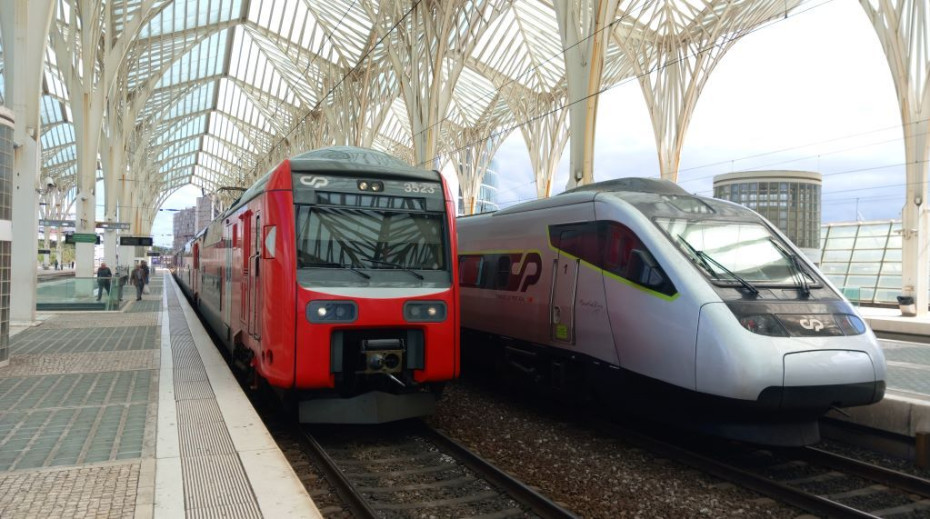
Portugal by train
This guide to travelling by train in Portugal will tell you all that's good to know, including how the ticketing works and the differences between the train services.
Share
For a comparatively small country, Portugal has a varied, but efficient railway network, managed by the national rail operator Comboios de Portugal (CP), which can also represent great value for money for travellers.
Depending on the route being travelled, you may be taken to your destination on one of Europe's sleekest express trains, or find yourself on a fabulously retro train, which will have the aura of having escaped from a museum.
Though what all Portuguese railway journeys taken by ShowMeTheJourney had in common was a inescapable sense that the trains and stations are well cared for.
There is easy access by train to multiple popular tourist destinations; the likes of Averia, Belem, Braga, Cascais, Sintra and Tomar all have rail stations - plus as can be seen below, a stunning rail line travels deep into the Douro Valley.
What's particularly worth knowing:
The 12 key things most worth knowing about taking the trains in Portugal are:
(1) Portugal has one main north <> south route which links Braga - Porto - Coimbra ↔ Lisboa ↔ Albufeira-Ferreiras - Faro and it is used by two express train services:
- the slower, older, but cheaper Intercidades (IC) services
- the faster, smarter, Alfa Pendula (AP) services.
Seat reservations are included when booking tickets for both services - Choosing specific seats from seating plans is part of the booking path on the CP website.
(2) The Alfa Pendular (AP) trains operate on these two routes:
- Lisboa-Santa Apolónia - Lisboa-Oriente - Coimbra-B - Aveiro - Porto-Campanhã - Braga
- Faro - Albufeira-Ferreiras - Tunes - Lisboa-Entrecampos - Lisboa-Oriente - Coimbra-B - Aveiro - Porto-Campanhã
(3) The Intercidades (IC) trains operate on these six routes:
- Lisboa-Santa Apolónia - Lisboa-Oriente - Entroncamento - Pombal - Coimbra-B - Aveiro - Porto-Campanhã - Braga / Guimares / Valenca
- Lisboa-Santa Apolónia - Lisboa-Oriente - Entroncamento - Castelo Branco - Covilhã - Guarda
- Lisboa-Santa Apolónia - Lisboa-Oriente - Entroncamento - Pombal - Coimbra-B - Guarda - Vilar Formoso (currently replaced by bus between Coimbra and Guarda; and between Guarda and Vilar Formoso)
- Faro - Albufeira-Ferreiras - Tunes - Lisboa-Entrecampos - Lisboa-Oriente
- Evora - Casa Branca - Lisboa-Entrecampos - Lisboa-Oriente
- Beja - Casa Branca (connecting service)
The stations in Lisbon
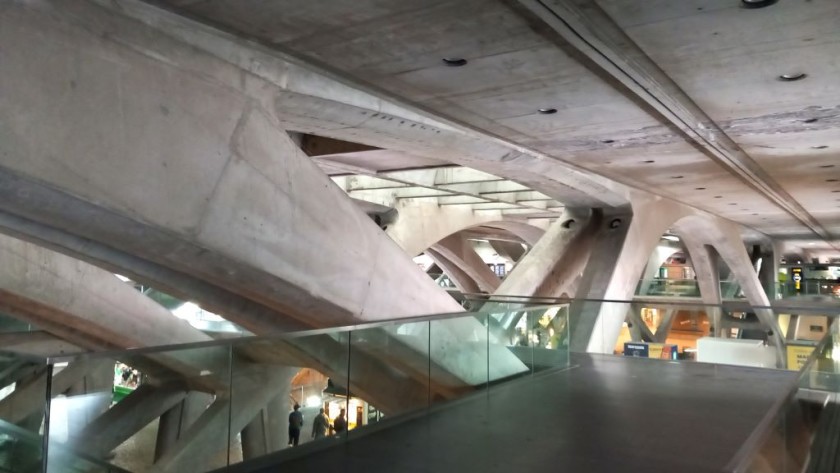
The stations in Lisbon
(4) Lisboa-Oriente station lives up to its name, Lisbon-East, as it is located some-distance from Lisbon city centre.
It was built to serve a new business district on the north-eastern edge of the city; similar to Canary Wharf in London and La Défense in Paris.
It is served by the Red Line of the Lisboa Metro, which connects Oriente station with Lisbon Airport.
The quickest route between Oriente station and the historic heart of Lisbon is to take local trains between Oriente and Santa Apolónia stations, to connect with the Blue Line of the Lisbon Metro at Santa Apolónia.
(5) Note that the trains between Lisbon/Lisboa and Faro, in the Algarve, don't depart from Santa Apolónia - which is the city centre station in the capital used by the long-distance trains between Lisbon and the north.
The closest station to the city centre / old town in Lisbon, that these trains depart from / arrive at is Lisboa-Entrecampos - which is served by the Yellow Line of the Lisboa Metro.
Though an easier option can be taking local trains between Oriente and Santa Apolónia stations, in order to connect in and out of the trains to and from Faro.
(6) Some of the AP trains on the Lisboa ↔ Porto route have their journeys extended to and from Faro.
So there are more trains between Lisboa-Oriente station and Porto, than between Lisboa-Santa Apolónia station and Porto.
These AP trains on the Faro ↔ Porto route also call at Lisboa-Entrecampos station.
(7) In addition to Santa Apolónia, Entrecampos and Oriente, there are two other main stations in Lisbon:
- Cais do Sodré - which is used by local trains between Lisbon city centre and Cascais via Belém and Estoril
- Rossio - which is used by local trains between Lisbon city centre and Sintra.
The stations in Porto
(8) The express trains to and from Porto do not serve São Bento station, which is located in the heart of the city's historic area.
Instead they depart from and arrive at Porto-Campanhã station, which is on the western edge of the city centre.
Though all of the local mainline trains link Campanhã and São Bento stations - and Campanhã is also on the Porto Metro.
Booking tickets
(9) Registration is required for booking on the on the CP website - Though in my experience signing up and then immediate booking wasn't possible, I had to exit the site and then sign-in to begin a new session.
So using Omio can be a simpler alternative, particularly when making a booking from outside Europe.
(10) A factor in Omio being a simpler booking service to use is that ID is required when travelling on Portuguese trains, so the form of ID which will be used (passport, driving licence, ID cards) needs to be selected on the CP website - and the corresponding number needs to also be entered.
However, despite signing up to register with CP, the website does not retain these numbers, so when making a repeat booking, or checking info such as seating plans , you will need to have these numbers to hand.
(11) The discounted 'Promo' tickets for journeys for journeys by the AP and IC trains are placed on sale from 60 days ahead - and the prices can be more than 50% lower than ordinary tickets.
It's possible to travel in 2nd class on an IC train between Lisbon and Porto for only €10 and travelling by the AP trains can only cost a few euros more.
(12) Visitors to Portugal who meet certain criteria at the time of travel - those aged 4 - 25 and those aged 65 and over, can travel at discounted rates.
Offers are also available at certain times when travelling as a families or in groups of 3 or more people.
Though when booking on the CP website you need to take care to proactively select the types of ticket which match the travel party - CP won't automatically offer a type of ticket based on age or number of travellers.
Links to Useful Info
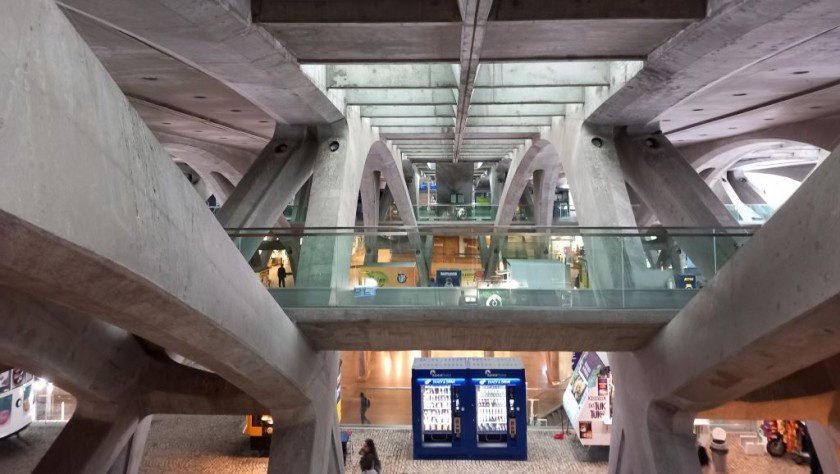
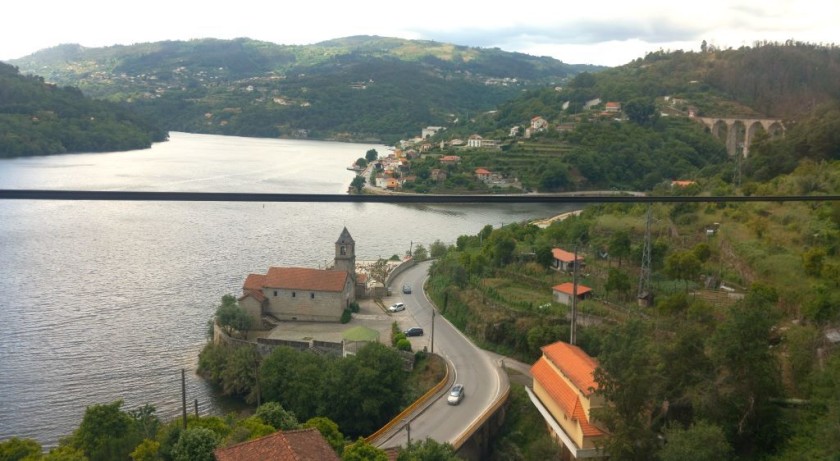
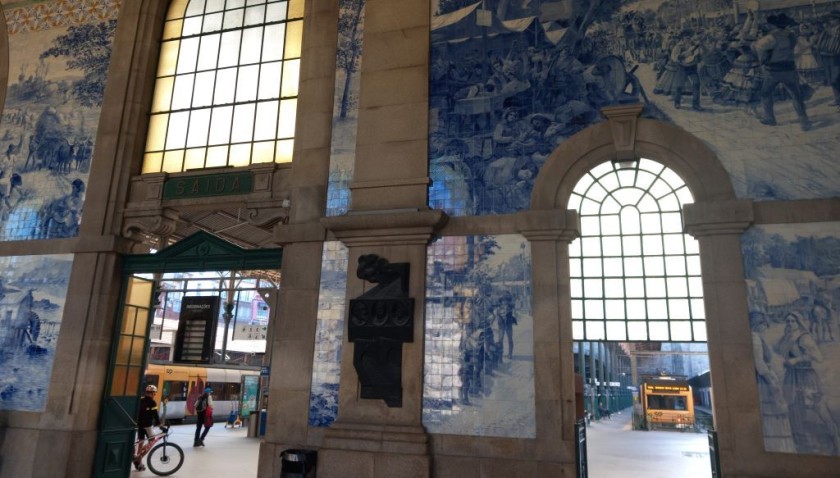
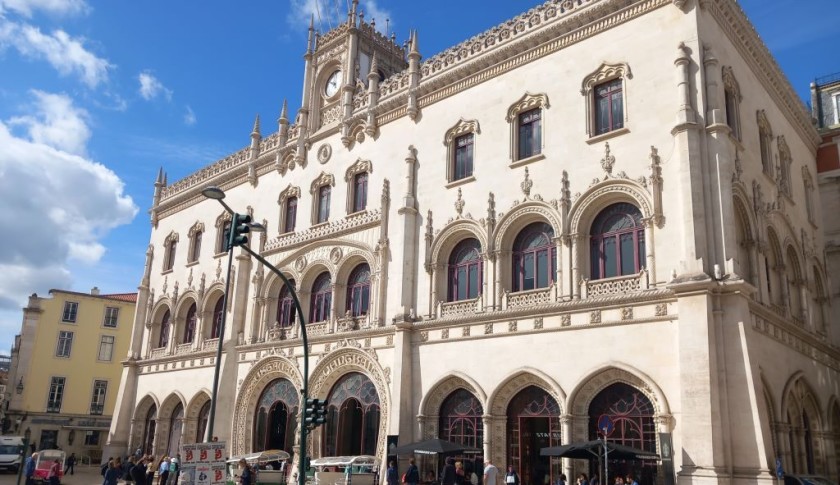

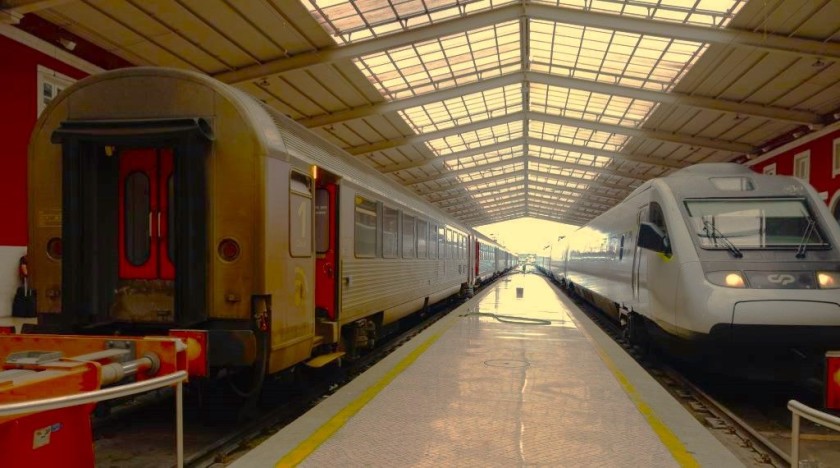

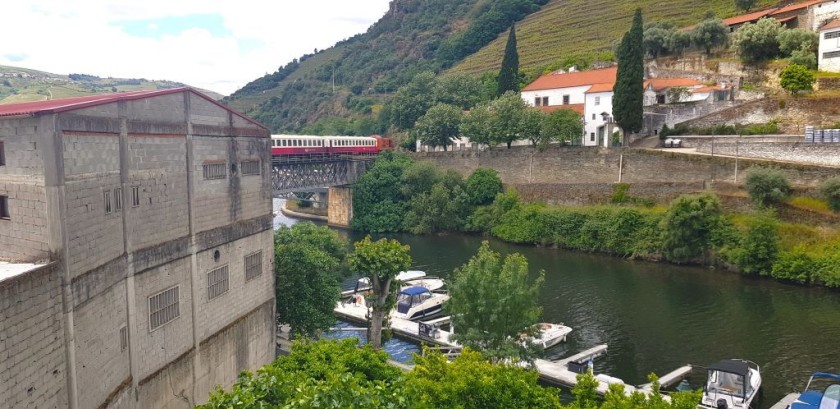
Travelling on Portuguese trains
Comboios De Portugal, CP is the national rail operator in Portugal and it places its trains into five categories:
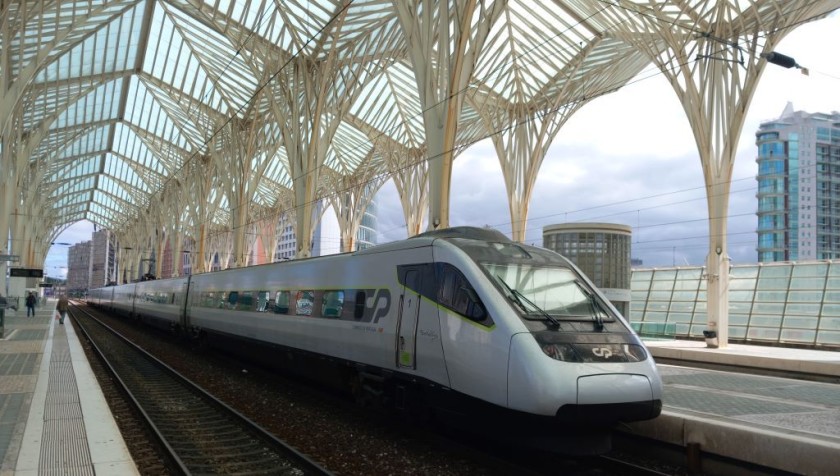
- Alfa Pendular (AP) = Portugal's fastest trains, which tilt so that that they can travel at up to 220 km/h (135 mph) on the 'classic' lines. There are no high speed-lines in Portugal.
Non-folding bicycles cannot be taken on these trains.
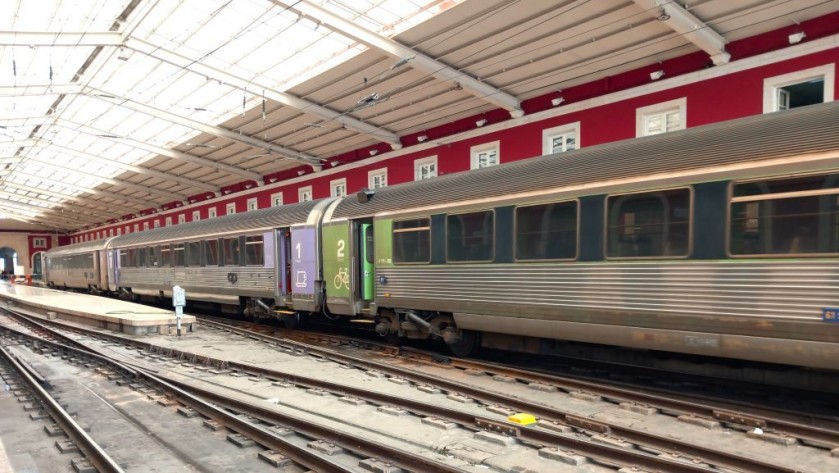
2: Intercidades (IC) = More conventional long-distance express trains, which are hauled by locomotives.
Most of these IC services are formed of coaches based on French 'Corail' trains, which set new standards of comfort when they were introduced back in the 1980s , but they are inevitably now looking a tad tired.
Though newer trains are used for the Beja ↔ Casa Branca shuttle service.
3: InterRegional (IR) = Fast trains on shorter distance routes, such as:
- Porto ↔ Valenca
- Porto ↔ Regua
- Lisboa ↔ Caldas da Rainha - Verride - Coimbra
- Lisboa ↔ Tomar (less frequent, but faster than the Regional trains)
Seat reservations are not possible on the InterRegional services.
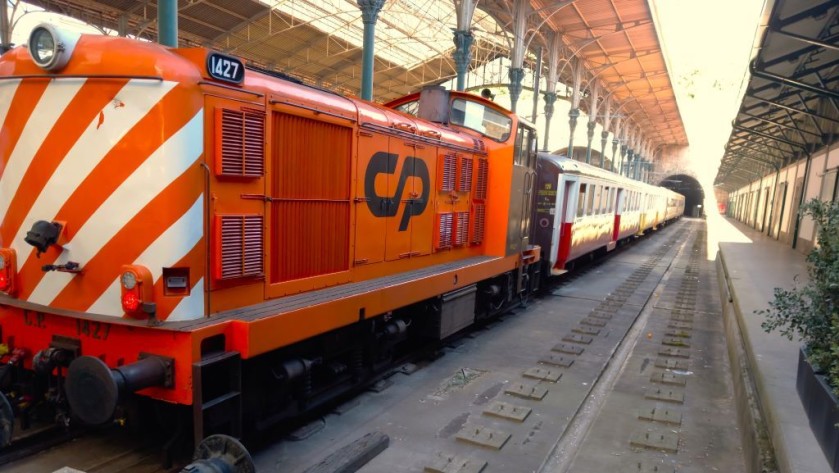
The charmingly retro trains on the Porto ↔ Pochino route along the Douro Valley, are also classified as InterRegional services.
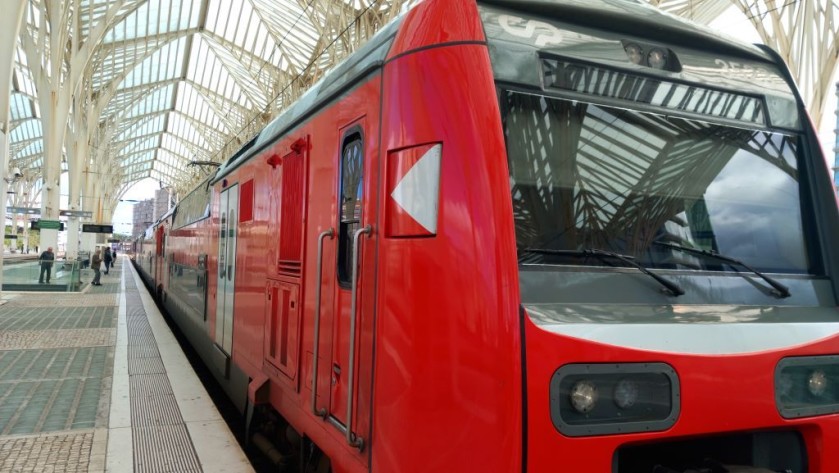
4: Regional (R) = These are trains which tend to stop at all stations on their route, though they can skip stations when they share a route with 'Urban' services:
Services comprise a wide variety of trains, though smart double-deck trains are used on many of the services which travel to/from Lisbon.
Regional routes popular with tourists include:
- Lisboa ↔ Tomar
- Faro - Albufeira-Ferreiras - Tunes - Portimao - Lagos (The Algarve Line)
- Faro ↔ Vila Real S. Antonio
Seat reservations are not possible on Regional services.
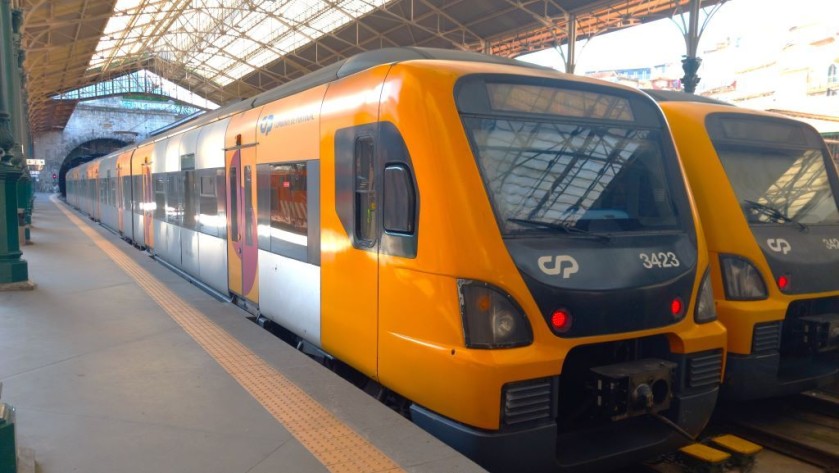
5: Urban / Suburb Services = The networks of local / commuter trains in Lisbon and Porto and Coimbra.
Urban routes popular with tourists include:
- Porto ↔ Braga
- Lisboa ↔ Sintra
- Lisboa ↔ Cascais
Good to know about the trains in Portugal
As can be seen above there is inevitably a wide variation of the types of train used in Portugal, but these aspects of travelling on CP's trains are universal:
2nd class = Turistica / Tourist
1st class = Conforto / Comfort
- It won't be particularly obvious, but the Portuguese trains are larger than the European average, because the gap between the rails on the tracks is wider than what's typical.
Therefore many of the trains in Portugal are notably roomy - in particular the seats and seating area can be wider than in other countries, partially because CP doesn't tend to exploit this extra width by using 3+2 seating layouts. - ID is required when travelling on all but the Urban Services, and the form of ID you will be using needs to be entered when booking tickets on the CP website - so you then need to have it with you when taking the train.
- When inspecting tickets on the AP and IC trains, the train conductor will know the names of the travellers who have been assigned each seat, so they will ask for your name(s) and check it off.
Catering
CP's trains do not offer at seat catering from a trolley service, or an attendant; On the AP and IC trains a bar / bistro car is available.
Travelling First Class
Due to the lack of at seat catering, the core benefits of travelling in Conforto / Comfort is the ambience - more leg room and wider, more comfortable seats arranged 2 + 1 across the aisle, instead of 2 + 2.
Bikes
Non-folding bicycles can be taken on all trains except the AP services and tickets are not required.
On the IC trains, up to two bike spaces are available in 2nd class coaches and the bikes must be placed in these - there are symbols by the doors which are adjacent to the bike spaces.
However, spaces cannot be reserved in advance - so if they're in use you may be denied boarding by the conductor.
Also you may need to find a space for your bike in a different coach to that in which your reserved seats will be located.
On the regional (R and IR) trains you can bring non-folding bikes on board and place them in non-dedicated areas. as long as you don't block the access to the train by other passengers.
So the conductor may be prevent bikes being taken on board if the train is exceptionally busy.
On the Urban trains, you can, in theory, board into any train.
Booking tickets for long-distance train journeys in Portugal
When booking tickets online for journeys by the AP, IC and IR train services in Portugal, it's good to know that:
- Tickets can be booked either with Omio, or on the website managed by CP, the national rail operator.
- Both websites require registration in order to make a booking - though on the CP website you may need to register and exit and then re-open the site to proceed with a booking.
- Only up to two types of ticket will be available: (1) Regular, full-price tickets which have no special name; and discounted Promo tickets.
- ID is required when travelling - so the form of ID you will be using; passport, driving licence, ID card etc, needs to be entered when booking, so have it to hand.
- Tickets need to be printed and taken with you; unless you book by using the CP app (tickets can be stored in the app).
Saving money
When booking journeys by the Alfa Pendular (AP) trains or the Intercidades (IC) trains, only up to two types of tickets will be available: (1) Regular, full-price tickets that don't have a specific name; (2) Promo tickets, which are cheaper.
These discounted Promo tickets will be released in limited numbers, so they can sell out completely up to around a month ahead on the most departures.
Tickets are placed on sale 60 days ahead of departure.
If you book 8 or more days in advance, the discounts can be as much as 65%.
Though these cheapest tickets of all, Lisboa ↔ Porto for €10 in 2nd class on IC trains and €12 on AP trains, inevitably sell out quickly.
When they're gone, they will be replaced with limited numbers of Promo tickets at a more expensive price.
You can change the date and time of Promo Tickets, but they cannot be refunded.

When looking up a journey by AP or IC trains on the CP website, if a Promo ticket is available you will see its cheaper price on the journey options page - to the right of the regular price.
Having selected a departure on which Promo tickets are available, you will not be automatically offered the Promo price on the next screen.
Though as seen above - What won't be obvious is that you will instead be offered a regular ticket, so you will have to proactively select the 'Promo ticket' offer.
But if you book with Omio you will automatically be offered the cheaper price per departure.
Refunds and Exchanges
Any ticket for a CP service can be be exchanged to another departure if the route and train service are the same.
Though for Promo tickets the the new travel date must be five (when traveling by by IC train), or eight (when travelling by AP train) or more days in the future - and Promo tickets must also still be available on the train you wish to transfer to
Refunds
In general tickets can be refunded up to 15 mins before departure - but the exceptions which can't be refunded, include Promo tickets and Trainsharing tickets.
Seat reservations
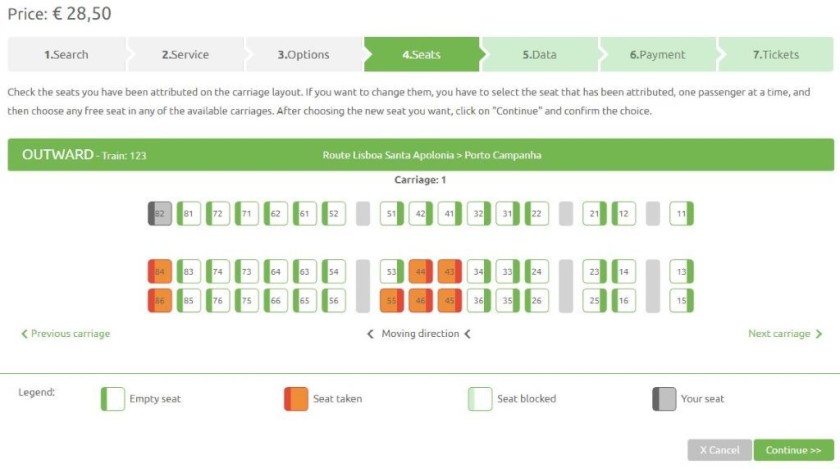
When booking journeys by the Alfa Pendular (AP) trains or the Intercidades (IC) trains, on the CP website, you will need to choose specific seats on a seating plan.
Though if you book with Omio you will be assigned seats.
You must then travel in these specific seats included with the booking - the names of each traveller will then be assigned to the seat(s) and when checking tickets the conductor will ask for the name of each seat occupant.
Children
Children aged 3 and under are entitled to travel free of when accompanied by an adult, though they must travel in the adult's lap.
Children aged 4 to 12 receive a 50% discount and they can travel in their own seat
Proof of the entitlement to these discounts, such as a passport, must be taken on the journey.
Youths
Those aged 13 to 25 inclusive qualify for a 25% discount on ticket prices, but you must have proof of your age with you when taking the journey.
Seniors
Those aged 65 and can purchase tickets for half price, provided that they bring proof of age with them, either an official identity document or a certified photocopy.
Groups
If 3 or 4 people will be travelling together on a Tuesday, Wednesday or Thursday on an Alfa Pendular (AP) or an Intercidades (IC) train, you can book together and receive a discount of 40% or 50% off, respectively - these are known as 'Trainsharing tickets'.
When booking return tickets, you must also travel back on a Tuesday to Thursday.
Though exceptions apply to Tuesdays if a Monday is a public holiday - and to Thursdays if a Friday is a public holiday.
Family and Friends Ticket
Groups of 3 to 9 people, regardless of whether they are members of the same family or not, can receive 50% off the total price when travelling in 1st or 2nd class on a Saturday or Sunday.
Though the cost calculation is based on the full price of tickets for children and seniors - and at least one adult (aged 13 or over) must be included in the travel party.
The Family and Friends Ticket ticket must be purchased at the same time for all members of the group, up to 60 days in advance at CP ticket offices, travel agencies with a CP contract, or on the train when boarding at stations without ticket sales - note that it cannot be booked online!
A return journey can be made on Saturday or Sunday of the same weekend or any other weekend, subject to the validity of the ticket.
Though for journeys by the Alfa Pendular (AP) trains or the Intercidades (IC) trains, two further conditions apply:
- The travel date must be between Oct 1st and April 30th
- Many Sunday departures, including any train which begins its journey after 11:30am, are excluded.
Dogs
Dogs can be taken on the Urban trains, with no need for a ticket, but on the other train services tickets are required if the dog isn't transported in a pet-carrier.
These tickets must be booked at stations - the charge is a full price ticket at the Adult rate for travel on the AP and IC trains, and 50% of the Adult rate the Regional (R, IR) trains.
Though if your dog can be transported in a pet-carrier it can be taken on board as hand-luggage, but it must then travel in the pet-carrier.
The regulations which apply when NOT using a pet-carrier and travelling with a dog on any train are:
- the dog must be muzzled
- the dog must be on a short leash,
- the owner must have the animal's vaccination card with them and a valid licence
- the dog must stay on the floor.
Notes on using the major stations in Portugal:
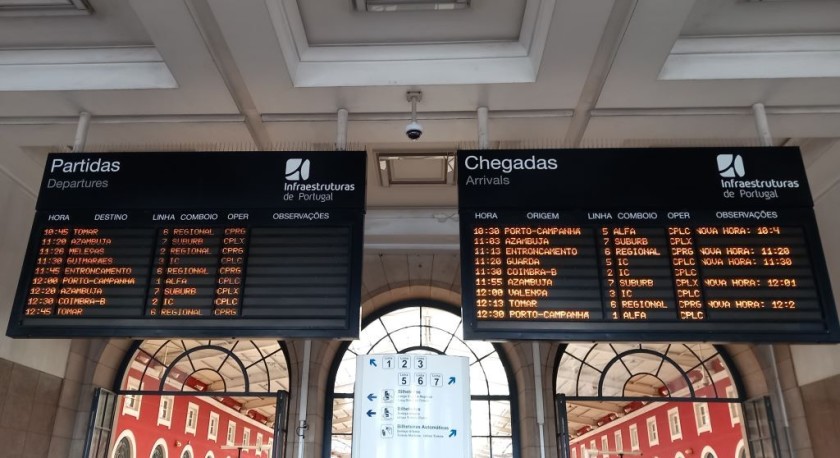
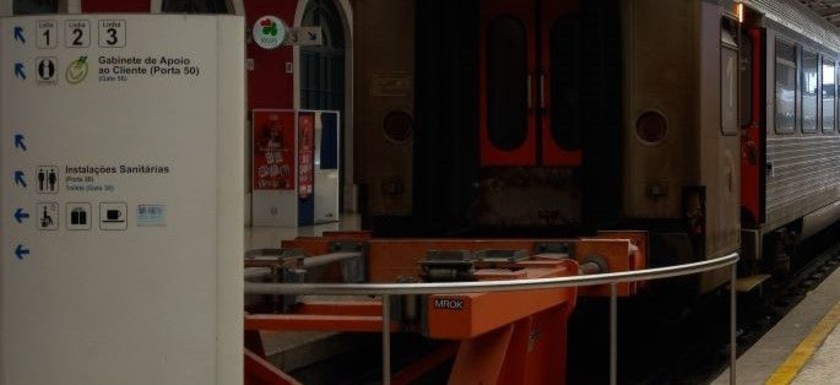
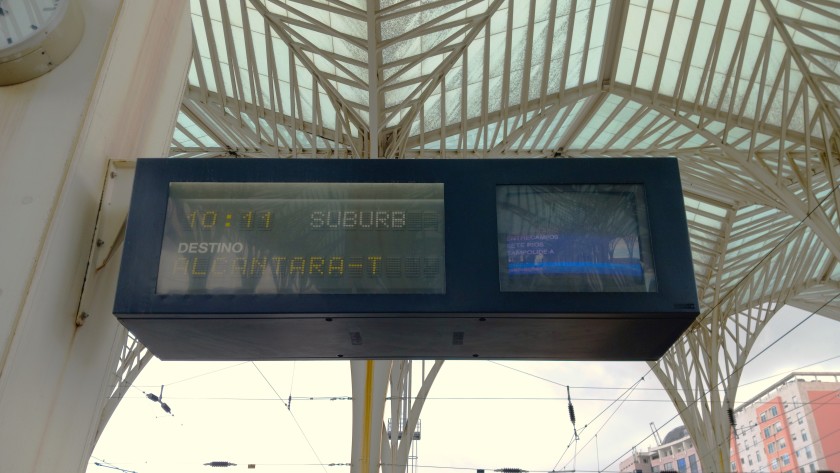
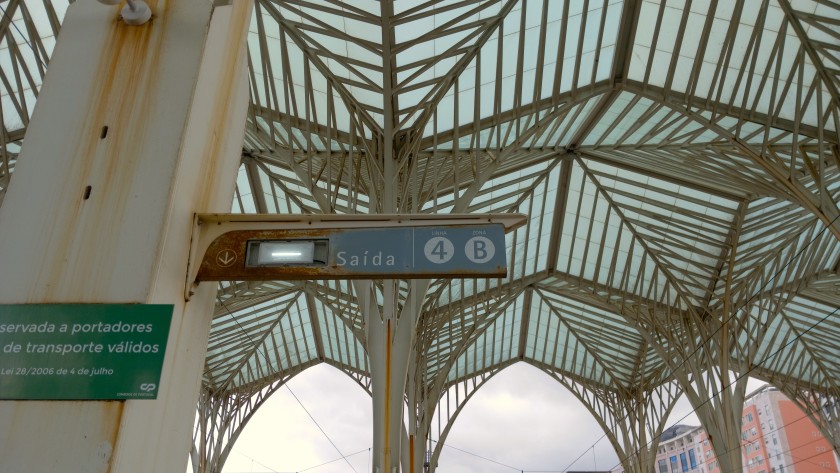
Track / platform = Linha
Train = Combio
Time = Hora
Departures = Partidas
Arrivals - Chegadas
A comparatively unusual feature of the larger stations in Portugal is that they don't have info signs /boards which hang down from ceiling.
Instead the info is on boards, with a white background. which are attached to the floor.
Boarding
On the info screens the departures are listed in order of departure, with next to leave at the top, but what's unusual is that the track / platform / linha that the train will be leaving from, is visible as soon as the train is listed.
So if you will be boarding at a station where a train will be commencing its journey - If the train is already at the track / platform, you can board it, no matter how long it will be before the train will be leaving the station.
Sounds simple and logical, but that isn't the norm at most European stations.
In Portugal there is no racing towards a train because its track / platform number doesn't appear on an info screen until 10-20 mins prior to departure.
Though you will also need to check that the train you will be taking, may not actually be the next train leaving from that particular track / platform - a train already at the track / platform may be heading to a different destination.
At intermediate stations
If you will be joining an AP or IC train at a station where the train will be calling during its journey, you will ideally be wanting to wait where you can have easy access to the coach in which your reserved seat will be located.
The track / platform / linha can be divided into zones (zonas), but the departure screens don't show any info as to which coaches will occupy each zone when the train arrives.
Though on AP and IC trains heading north the coaches are arranged with the lowest number at the rear - and these are the 1st class coaches
So on AP and IC trains heading south, the 1st class coaches will be towards the front of the train and the coaches with the higher numbers will be towards the rear of the train.
Something else to look out for is that the large numbers 1 and 2 on the exteriors of the coaches used by the IC trains, aren't the numbers of the coaches, instead they indicate whether the coach is 1st or 2nd class.
Though the large numbers on the exteriors of the AP trains are the coach numbers.
By train from and to Portugal
Unfortunately the Spanish national rail operator Renfe, cancelled the night trains that it had operated on two routes between Lisboa and both Madrid and north-west Spain at the start of the pandemic and they won't be coming back.
So what remains is the two sets of daytime train services which both only travel to/from the nearest city over the Spanish border:
- Porto ↔ Vigo
- Entroncamento ↔ Badajoz; on the Lisboa ↔ Madrid route
Meaning that connections are required, both when travelling between Spain and Lisboa/Lisboa by train; and between Portugal and any other city in Spain.
Porto ↔ Vigo
There are two direct trains per day in each direction, which are branded 'Celta' and link Porto in Portugal with Vigo in Spain.
They also call at Nine (for connections to and from Braga) and Viano do Castelo and Valenca.
The Celta train service has different terms than the trains which solely operate within Portugal.
The key differences are;
- the discount is 40% for children
- the discount is 25%, for persons aged 60and older.
- one dog of up to 10kg can be carried per passenger, in an appropriate container which must not exceed 60x35x35cm.
The stations
In Porto these 'Celta' trains depart from and arrive at Porto-Camphana, the city's main station and in Vigo they depart from / arrive at Vigo-Guixar station.
However, this station is now the secondary station in Vigo, as the city now has a shiny new station dedicated to high-speed train services, named Vigo-Urzáiz.
Hence Vigo-Urzáiz station is used by faster trains to/from Pontevedra, Santiago de Compostela and A Coruna - And the trains which link Vigo with Madrid and Ourense.
On Google Maps it will look as though these two stations in Vigo are around 10 to 15 mins walk from each other, but the route is blocked by a highway and Vigo-Urzáiz is also at an upper level, on top of a hill in the city.
The local bus route / line 883039 links the two stations, but its service is so sporadic that taking a taxi is the only viable option for making a transfer between the two stations.
Though as will be seen below, an overnight stay in Vigo is often required when taking the longer rail journeys between Porto and the more distant locations in Spain.
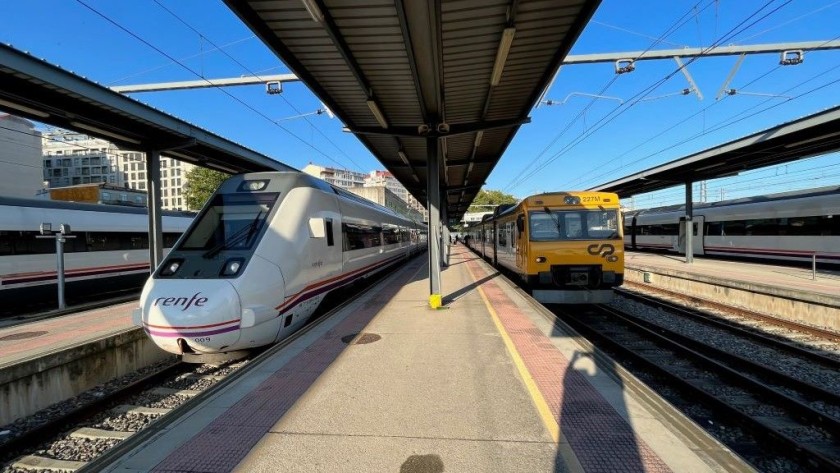
The Regio trains that use the older 'classic' lines when travelling between Vigo and Pontevedra, Santiago de Compostela and La Coruna also depart from / arrive at Vigo-Guixar.
The image above was taken at the station by Jon Worth ad downloaded from Wikimedia Commons - Jon is a campaigner for better cross-border rail services in Europe, hence his excellent website.
However, this station is now the secondary station in Vigo, as the city now has a shiny new station dedicated to high-speed train services, named Vigo-Urzáiz.
Hence Vigo-Urzáiz station is used by faster trains to/from Pontevedra, Santiago de Compostela and A Coruna - And the trains which link Vigo with Madrid and Ourense.
to/from Barcelona via Leon and Zaragoza
The other train service which arrives at depart from Vigo-Guixar station is the 3 x days per week Alvia train on the Vigo ↔ Ourense - Leon - Burgos - Pamplona - Zaragoza - Barcelona route.
It departs from Vigo on Monday, Thursday and Saturdays; and arrives in the city on Wednesday, Friday and Sundays.
On the other days of the week connections are required in Ourense when travelling from and to Vigo.
Though this train departs Vigo before the first train of the day will arrive from Porto; and the train from Barcelona arrives in Vigo after the final train of the day has departed for Porto.
So an overnight stay in Vigo is required when travelling between Portugal and the destinations served by the Vigo ↔ Barcelona train.
Lisbon to Vigo
The train which departs at Porto at 08:13 leaves before the first train of the day will have arrived from Lisboa / Lisbon.
- Depart Lisboa-Santa Apolónia: 14:00 by AP train
- Arrive Porto-Camphana: 17:00
- Depart Porto-Camphana: 19:10
- Arrive Vigo Guixar: 22:34
The connections on the CP website suggest an 18 minute connection in Porto from an IC that departs Lisboa at 15:30, but this connection is not guaranteed.
Porto to Madrid
As will be seen below, travelling from Porto to Madrid by train in a single day is easier than making this rail journey in the opposite direction.
- Depart Porto-Camphana: 08:13
- Arrive Vigo Guixar: 11:35
- Depart Vigo Guixar: 12:31
- Arrive Pontevedra: 13:02
- Depart Pontevedra: 13:36
- Arrive Madrid-Chamartin: 17:36
This train to Madrid departs from Vigo Urzaiz station, but the connection in Pontevedra avoids the need to make the transfer between
stations in Vigo.
Porto to Santiago De Compostela and A Coruña
- Depart Porto-Camphana: 08:13
- Arrive Vigo Guixar: 11:35
- Depart Vigo Guixar: 12:31
- Arrive Santiago De Compostela: 14:06
- Arrive La Coruna-San Cristobal: 14:44
Madrid to Porto
- Depart Madrid-Chamartin: 11:20 not Sundays
- Arrive Vigo Urzaiz: 15:38
- Taxi to Vigo Guixar
- Depart Vigo Guixar: 19:56
- Arrive Porto-Camphana: 21:18
The alternative to spending more than four hours in Vigo between trains:
- Depart Madrid-Chamartin: 14:41 not Saturdays
- Arrive Santiago De Compostela: 17:42
- Depart Santiago De Compostela: 18:32
- Arrive Vigo Urzaiz: 19:25
- Taxi to Vigo Guixar; note that this connection is not guaranteed
- Depart Vigo Guixar: 19:56
- Arrive Porto-Camphana: 21:18
A Coruña and Santiago De Compostela to Porto and Lisbon
- Depart La Coruna-San Cristobal: 05:30 on Monday to Friday
- Depart Santiago De Compostela: 06:11 on Monday to Friday
- Arrive Vigo Guixar: 07:40
- Depart Vigo Guixar: 08:58
- Arrive Porto-Camphana: 10:20
- Depart Porto-Camphana: 10:38 by IC train
- Arrive: Lisboa-Santa Apolónia: 14:00
A Coruña and Santiago De Compostela to Porto (pm)
- Depart La Coruna-San Cristobal: 15:50
- Depart Santiago De Compostela: 16:34
- Arrive Vigo Guixar: 18:03
- Depart Vigo Guixar: 19:56
- Arrive Porto-Camphana: 21:18
OR
- Depart La Coruna-San Cristobal: 17:00
- Depart Santiago De Compostela: 17:32
- Arrive Vigo Urzaiz: 18:26
- Taxi to Vigo Guixar
- Depart Vigo Guixar: 19:56
- Arrive Porto-Camphana: 21:18
Entroncamento ↔ Badajoz
Note that work is ongoing on the construction of a high-speed route between Madrid and Badajoz, as a consequence the timetables of the trains between these cities are subject to amendment and cancellation,
So these timings below are provisional and may not be available on your travel date.
They have been included to give an idea of what the journey by train typically entails.
Lisbon to Madrid: Option 1
- Depart Lisboa-Santa Apolónia: 07:30 by IC train
- Arrive Entroncamento: 08:32
- Depart Entroncamento: 09:09 by Regional train
- Arrive Badajoz: 12:54
- Depart Badajoz: 14:20 by R-train
- Arrive Merida: 15:06
- Depart Merida: 15:21 by MD train; 2nd class only - this connection is not guaranteed
- Arrive Madrid-Atocha Cercanias: 19:44
Lisbon to Madrid: Option 2
- Depart Lisboa-Santa Apolónia: 11:30 by IC train
- Arrive Entroncamento: 12:33
- Depart Entroncamento: 13:36 by Regional train
- Arrive Badajoz: 17:26
- Depart Badajoz: 17:43 by IC train, 2nd class only; not Saturdays
- Arrive Madrid Chamartin: 22:39
Madrid to Lisbon
- Depart Madrid Chamartin: 08:30 by IC train, 2nd class only; not Saturdays
- Arrive Badajoz: 13:34
- Depart Badajoz: 14:09 by Regional train
- Arrive Entroncamento: 15:52
- Depart Entroncamento: 15:59 by IC train
- Arrive Lisboa-Santa Apolónia: 17:00
Back-up train departs Entroncamento at 16:59, arrives Lisbon at 18:00.
Airport rail links
The airports in Lisbon and Porto aren't served by CP's mainline trains, but they are linked to them and the city centres by Metro services:
Lisbon
Lisbon Airport is served by the Red line of the Lisboa Metro.
Unusually for a metro station it has a staffed ticket office, so if it's open it can sell the public transport passes for Lisbon, including the Navegante Occasional card.
When I was in Lisbon I loaded a card with €30 of credit which more than covered:
- 6 x Metro journeys
- 4 x bus rides
- 3 x rides on the funiculars
- a return journey by tram to Belem
- a return journey by train to Cascais
- a return journey on the line 28 tram
The Red line of the Metro stops at Lisboa-Oriente station for a connection into trains on to destinations across Portugal - there are direct trains from Oriente to the likes of Braga, Coimbra, Faro, Guarda, Porto and Tomar.
to and from the city centre
However, it does not serve the tourist heart of Lisboa / Lisbon.
To access the stations at Rossio and Baixa-Chiado, a connection into the Green Line is required at Alameda station - lifts / elevators are available.
Porto
Porto Airport is served by Line E of the Porto Metro.
It connects the airport to the city's primary public transport interchange at Trindade.
At Trindade station connections are available by escalator and elevator to the line D which gets closer to the tourist heart of Porto with its stop at Sao Bento.
An easy cross platform interchange at Trindade is available to the multiple metro lines which stop at Porto-Camphana, the city's main rail station.
At Porto-Camphana, connections are available with trains to and from multiple destinations including Aveira, Braga, Coimbra, Viano do Castelo and Valenca.
Europe's most stunning riverside rail journey
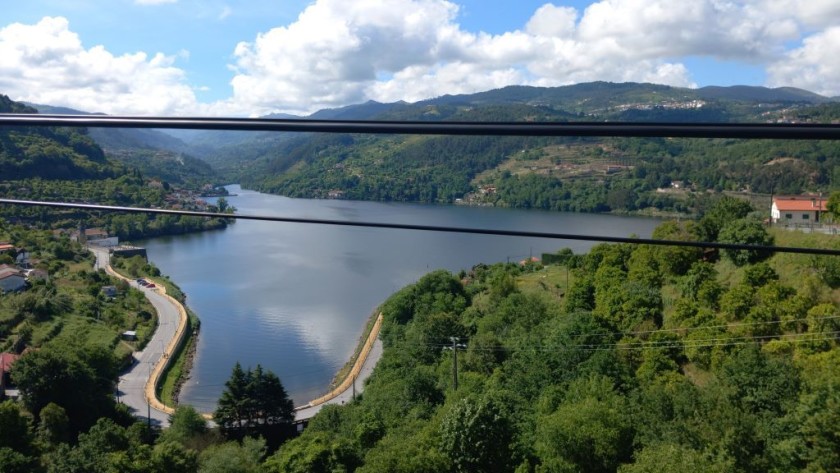
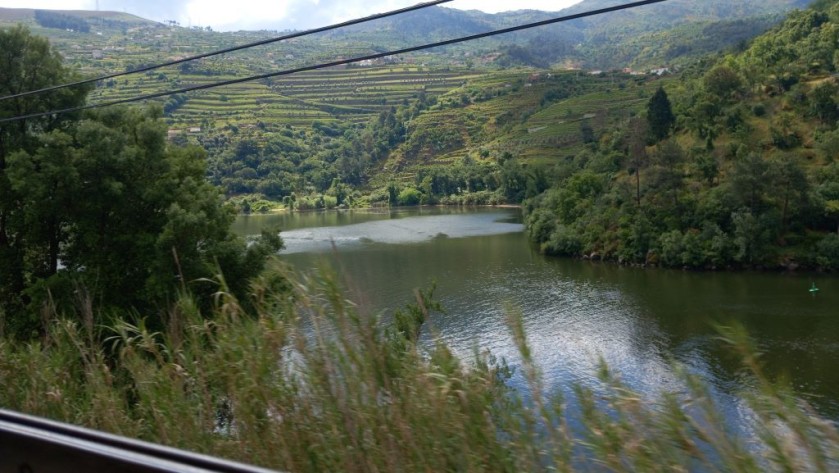
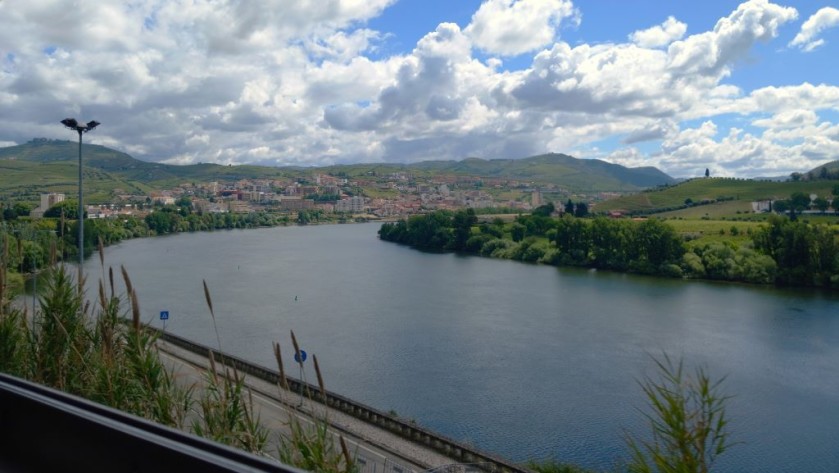
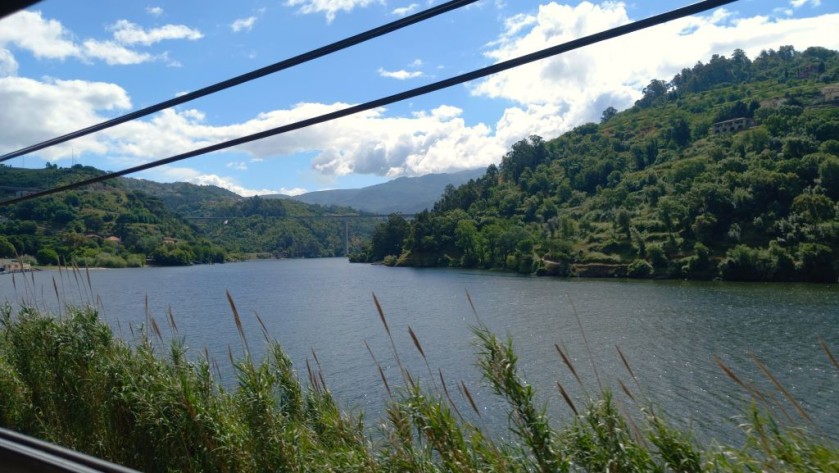
What makes the rail journey to and from Pochino so special is that the stunning views of the the Douro River Valley can be gazed at for more than two hours.
Also the railway rises and falls along the riverside, so for some parts of the journey you will be looking down on the stunning spectacle below you, but for other stages of the ride, the train is on the river bank, with views up and over to the vineyards across the water.
Between Pula and Ferradosa the river views are on the right when heading towards Pochino, but after Ferradosa they switch to the left; the train will cross a bridge shortly before arrival in Ferradosa.
An amazing day trip from Porto
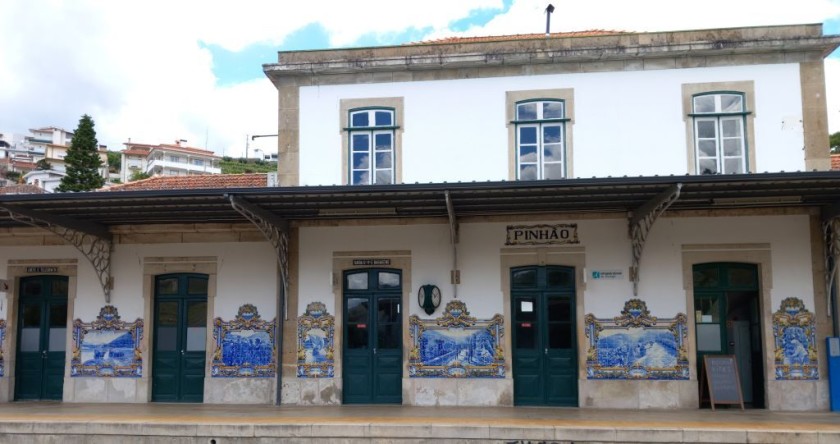

Taking in this incredible journey as a day trip from Porto is easily done.
The timetable allows for a return trip to the end of the line at Pochino, or to have a lunch in the charming village of Pinhao, as it has multiple restaurants by its lovely station - pictured above.
The Douro Historical Train
On certain days of the week from mid June until the end of October, a steam train operates on a lovely part of the route between Régua and Tua.
The train doesn't depart from Régua until 15:30 - and the timetable is arranged so that it's possible to leave Porto around 13:30 and return to the city at around 20:30.
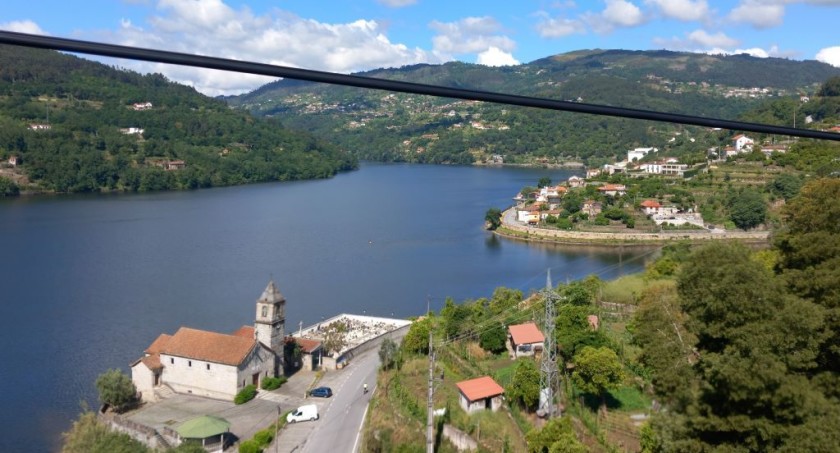

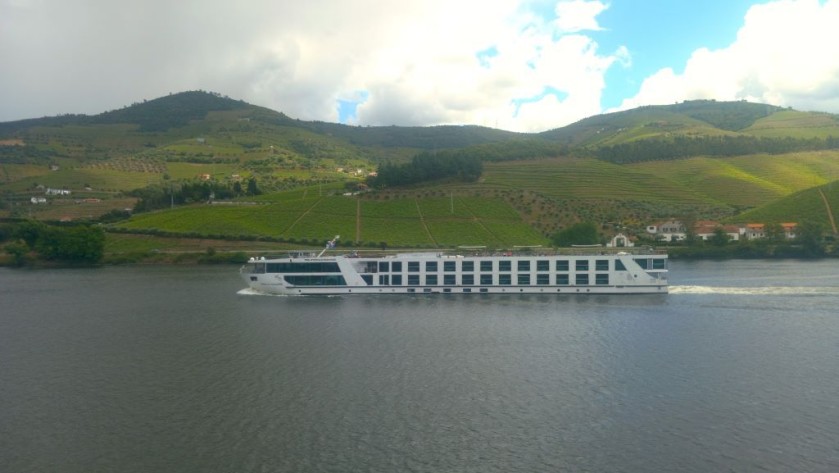
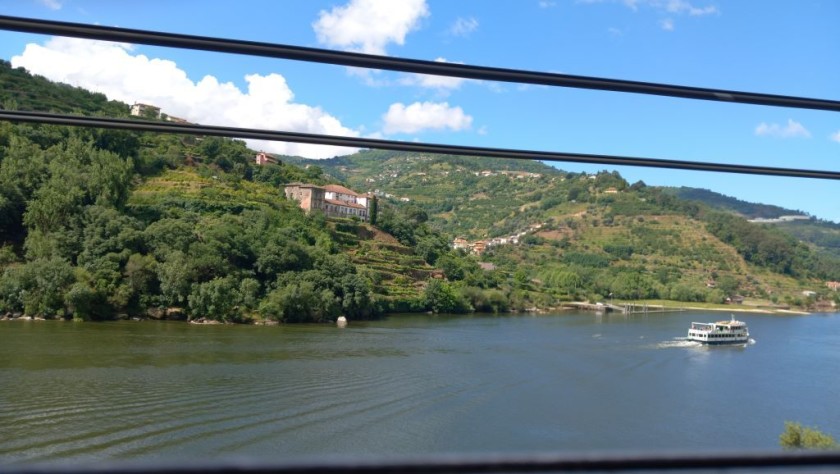

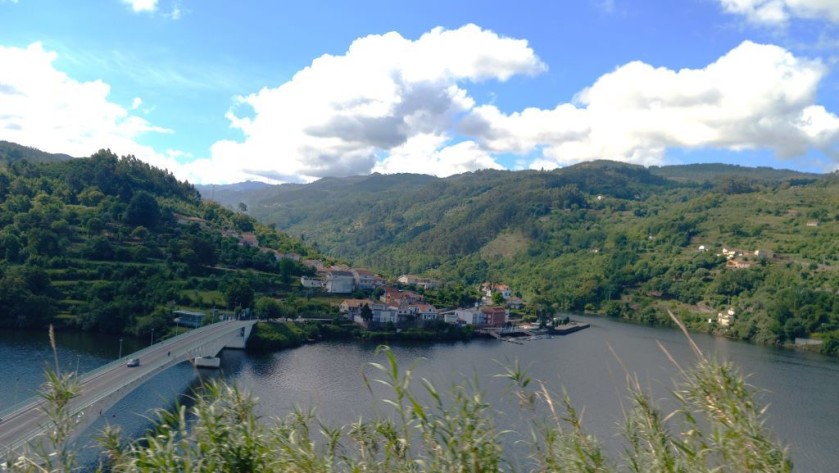
A luxury railway experience

The ultimate Portuguese rail travel experience is a ride on historic wonder that is the Presidential train.
On weekends in September and October the train takes the stunning Douro Valley railway to the end of the line, but the trip of a lifetime also includes:
- tasting the best wines from Douro estates on board, each of which showcases the best of its production
- a gourmet meal, plus local delicacies served on the return journey
- live music on board
- a tour guide
- a visit to a winery with port tasting.
Though the price per person is €750.
This second version of ShowMeTheJourney is exciting and new, so we are genuinely thrilled that you are here and reading this, but we also need your help.
We’re striving not to let anything get in the way of providing the most useful service possible, hence a facility has been set up with DonorBox which can be used to support the running costs and make improvements.
Instead of advertising or paywalls, your financial support will make a positive difference to delivering an enhanced service, as there’s a lot of ideas which we want to make happen.
So if you have found the info provided here to be useful, please consider saying thank you.

This is one of more than 100 train travel guides available on ShowMeTheJourney, which will make it easier to take the train journeys you want or need to make. As always, all images were captured on trips taken by ShowMeTheJourney.


